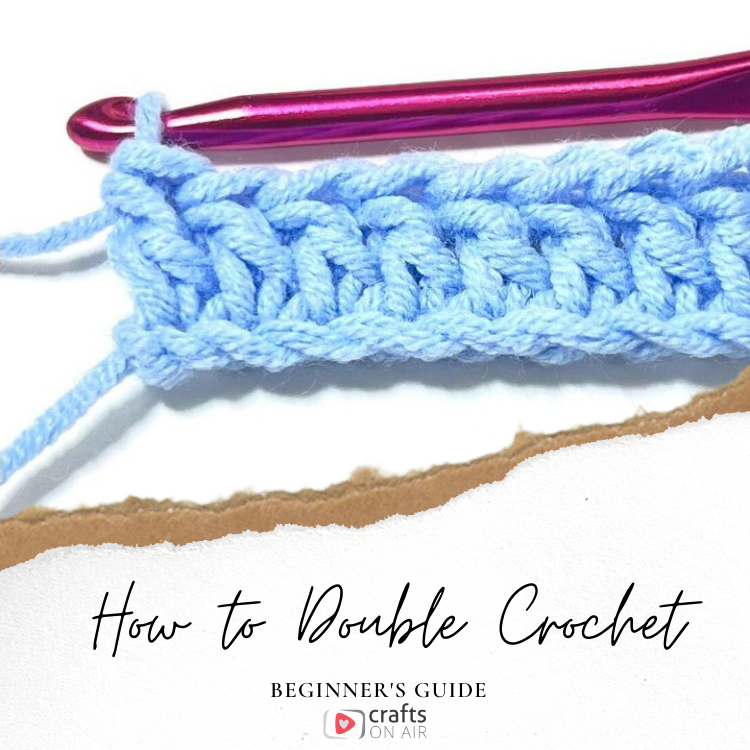
Introduction to the Double Crochet Stitch
The double crochet stitch (dc) is one of the fundamental crochet stitches you need to learn as you enter the world of crochet. The double crochet stitch may look complicated, but in reality, it's probably one the easiest stitches to learn. It’s perfect for making baby blankets, afghans, hats, dishcloths, or anything else you can think of.
In this blog post, we’re going to take you step-by-step through how to create the double crochet stitch as well as list down several double crochet stitch patterns you can get your hooks into once you’ve learned it!
I also have step by step video instructions for this stitch and 44 others in my Ultimate Crochet Stitch Library. I collected my favorite crochet stitches all in one place so you can learn with ease and start using these stitches in all your favorite patterns. Check out my library here.
What is a Double Crochet Stitch?
The double crochet (DC) is one of the most common crochet stitches and one of the easiest ones to learn! Crochet projects made using the double crochet stitch are looser and more flexible compared to ones made using single crochet or half double crochet.
An excellent reason to learn the double crochet stitch is that it’s incredibly versatile and opens up a whole load of patterns for you to work on. You can make amazing pieces with just rows of double crochet stitches, but you can also create other stunning patterns, including the much-beloved granny square and v-stitch!
You do a double crochet by yarning over before inserting your crochet hook into a stitch or chain, and then pulling up a loop. Then, you would yarn over and pull a loop through the first two loops on your hook. Finally, you would yarn over once more and pull a loop through the last two loops on your hook. We’ll go through the step-by-step for how to double-crochet below.
Easier for you to follow video instructions? Check out this stitch video tutorial and 44 more in my 2 day free crochet stitch library.
Double Crochet Abbreviation (dc)
Crochet terms are often abbreviated on patterns. Getting familiar with these abbreviations will make it easier for you to follow patterns and tutorials as you go along. For example, double crochet is abbreviated as dc while a single crochet stitch would be sc.
The abbreviations for the dc stitch and its affiliated terms are listed below:
| ABBREVIATION | DESCRIPTION |
|---|---|
| BPdc | Back Post Double Crochet |
| dc | Double Crochet |
| dc inc | Double Crochet Increase |
| dc dec | Double Crochet Decrease |
| dc2tog | Double Crochet 2 Stitches Together |
| edc | Extended Double Crochet |
| FPdc | Front Post Double Crochet |
Difference between the US vs UK Double Crochet Stitch
Beginners often get confused when different tutorials use different terms for what seems to be the same crochet stitch. This usually happens because of differences between American English (US) and British English (UK) terminologies.
The difference comes from how the stitch is defined in each country. Where UK terminology refers to the number of loops on your hook, the US terms refer to the number of yarn overs when pulling up your first loop.
For instance, a double crochet in UK terms would refer to the same stitch known as a single crochet in the US. Here’s a quick guide to telling the difference:
| US TERMINOLOGY | US ABBREVIATION | UK TERMINOLOGY | UK ABBREVIATION |
|---|---|---|---|
| single crochet | sc | double crochet | dc |
| half double crochet | hdc | half treble crochet | htr |
| double crochet | dc | treble crochet | tr |
| treble crochet | tr | double treble crochet | dtr |
Chart Symbol for Double Crochet
The symbols for the double crochet stitch and other related terms are listed below:
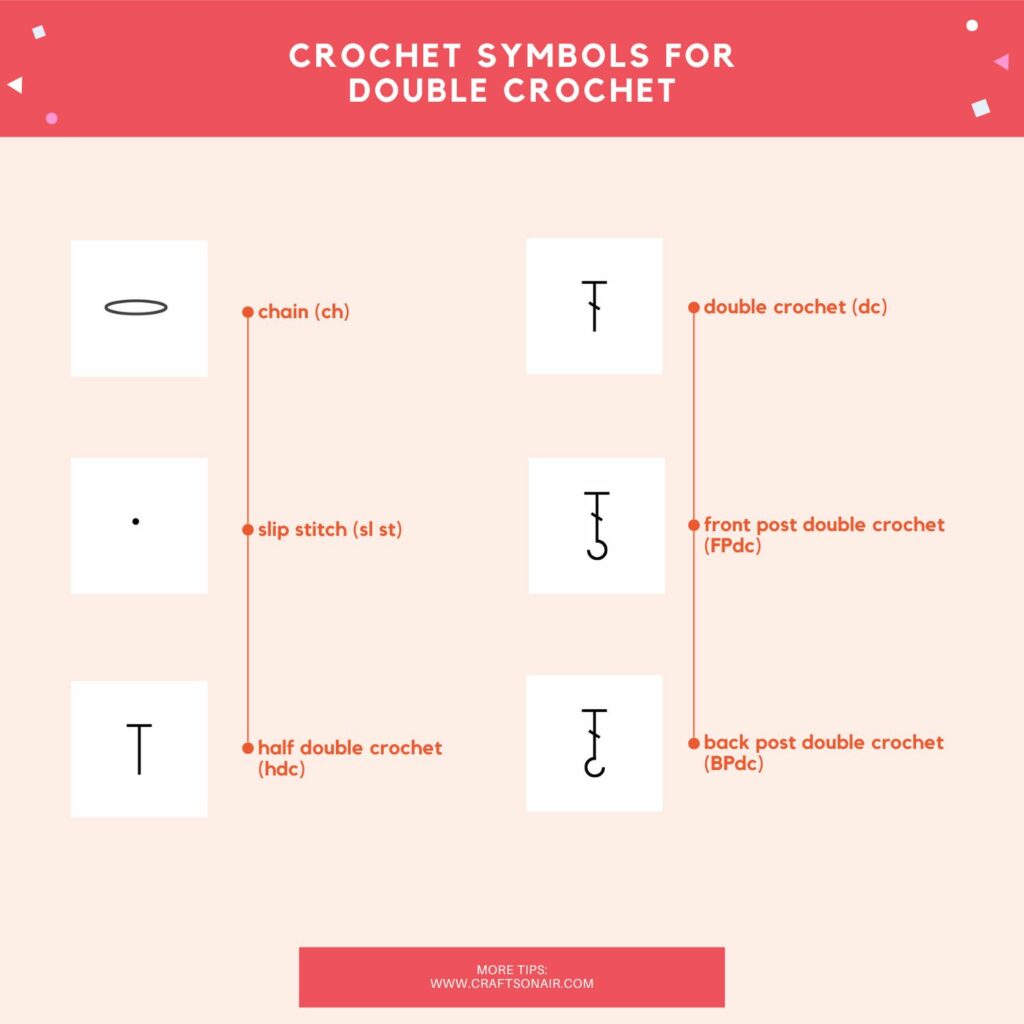
What are the Main Foundational Crochet Stitches?
Other than the double crochet, there are several other basic crochet stitches, namely:
- Single Crochet (sc)
- Half Double Crochet (hdc)
- Treble Crochet (tr)
Learning these basic stitches can open up a world of patterns for you to try out on their own, and some combine with each other to create some of the more unique crochet stitches out there.
Not ringing a bell? I’ve got you covered! You can learn all about the similarities and differences between these stitches along with other help for how to start crocheting in my Crochet Fundamentals course.
Anatomy of a Double Crochet Stitch
Before anything else, we need to talk about what a double crochet stitch looks like. All crochet stitches are made up of two parts: the top part, which forms the V on the top of the row, and the post part, which makes up the long part of your stitch and gives your project height as you go along. For the double crochet, the post is lengthened by a series of yarn overs and pull-throughs.
You might also notice that the loop on your hook at the beginning of a double crochet will always end up as the top part or the “V”. The two sides of the V are what make up the front loop and back loop. The front loops are always the ones closest to you, and the back loops are the ones furthest from you.
Let’s break down the components of the double crochet stitch so you can make the most out of this versatile stitch!
Stitch Height
A double crochet stitch is taller compared to its single and half double counterparts, giving your project more height more quickly. Where a single crochet would be the height of a single stitch, the double crochet is the height of two single crochet stitches.
The double crochet gets its post’s height from the initial yarn over before the hook is inserted into the stitch or chain below. Other taller, crochet stitches such as the treble and double treble would have you wrapping your yarn around your hook two or three times, respectively, before inserting into the stitch.
Front Post and Back Post of a Double Crochet Stitch
We’ve discussed the two parts of the double crochet stitch, the top and the post. Typically, we would crochet into the space between the top part and the post – just under the V on top. But for stitches like the double crochet, you have other options such as crocheting around the post of your stitch.
When working front post double crochet or back post double crochet you are actually forming the stitch around the post of the stitch from the previous row. To find the post of a stitch, first look for the chain at the top of the stitch. Just below that chain you’ll see the post of the stitch.
Front post double crochet and back post double crochet are distinguished by how you insert the hook into the post, which we’ll cover below.
Double Crochet Stitch Turning Chain
The turning chain refers to the chain at the beginning of every row. In order to achieve a straight edge on our work, we need to bring our yarn up to the same height as the crochet stitch we’re working with.
In order to reach the height of a double crochet, we need to chain 3 at the beginning of the row before making any double crochet stitches. Depending on your pattern, this chain 3 will usually count as the first double crochet in the row.
How to Determine the Right Side of the Double Crochet Fabric
If you’ve ever seen the terms right side and wrong side in a crochet pattern, you might have wondered what that meant and why it matters.
The front or outside of the work that is shown to the world is typically referred to as the right side, while the wrong side is the back or inside of the work.
The importance behind determining the right or wrong side of a project mostly lies in aesthetics. The right side looks the best, which makes it the side we want to present to the world.
The quickest and easiest way to determine the right side of your work is to look at the tail. This is the piece of yarn that’s left over from your slipknot at the beginning of your work. If you crochet with your right hand and the tail is at the bottom left of your work, you are looking at the right side of your work.
Materials & Tools Used to Make a Double Crochet Stitch
Yarn
One skein of yarn. The Comfy Worsted Yarn from Knit Picks makes for a perfect yarn to practice on, but you can use what you have! Worsted or medium-weight yarn will often have the number 4 on the ball band.
Hooks
A crochet hook. Your crochet hook size depends on the weight of the yarn you picked. LoveCrafts has a wide array of crochet hook sets with all the sizes you could possibly need for any project. If you are using a medium/worsted weight yarn, you’ll want a hook in the range of I-K, or 5.5 to 6.5 mm.
Notions & Tools
While the top two things you need are your yarn and hooks, it’s always a good idea to have these extra tools nearby whenever you’re crocheting:
- Scissors
- Stitch Markers
- Darning Needles
- Tape Measure or Ruler
Double Crochet (dc) Step-by-Step Tutorial
Double Crochet Starting Chain
When you begin the double crochet stitch you will start by working into a chain. Your first double crochet will be worked into the 4th chain from the hook. This means that your starting chain should be the length of the project you desire plus 3 stitches. For the purposes of this tutorial, begin by making a slip knot and chaining 14.
Note: If you need help with any of these terms, or prefer to learn from video, check out my Crochet Fundamentals course to learn the basics and beyond!
Now let’s get into the meat of it: how do you start a double crochet stitch?
Double Crochet Row 1
To start your row, yarn over (yo) your hook with your working yarn, skip the first three chains from the hook, and insert the hook into the 4th one from front to back.

Pull your yarn through the chain. You should have three loops on your hook.
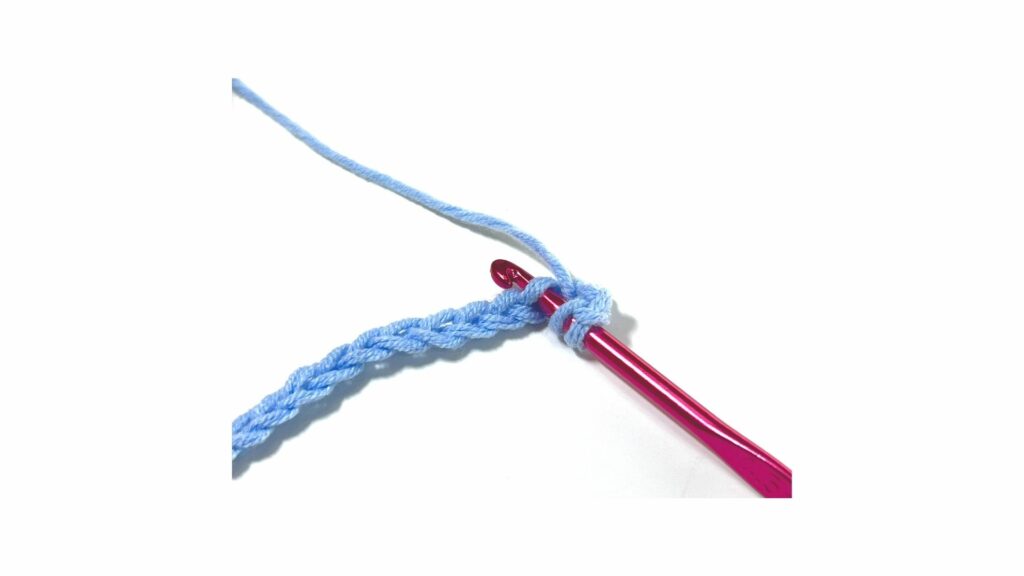
YO and pull through the first two loops as shown below. You should now have two loops left on your hook.

YO again and pull through the last two loops. Congratulations, you’ve just made your first double crochet stitch (dc)! You should now have one loop left on your hook and you can continue to make dcs in the same manner across the row.
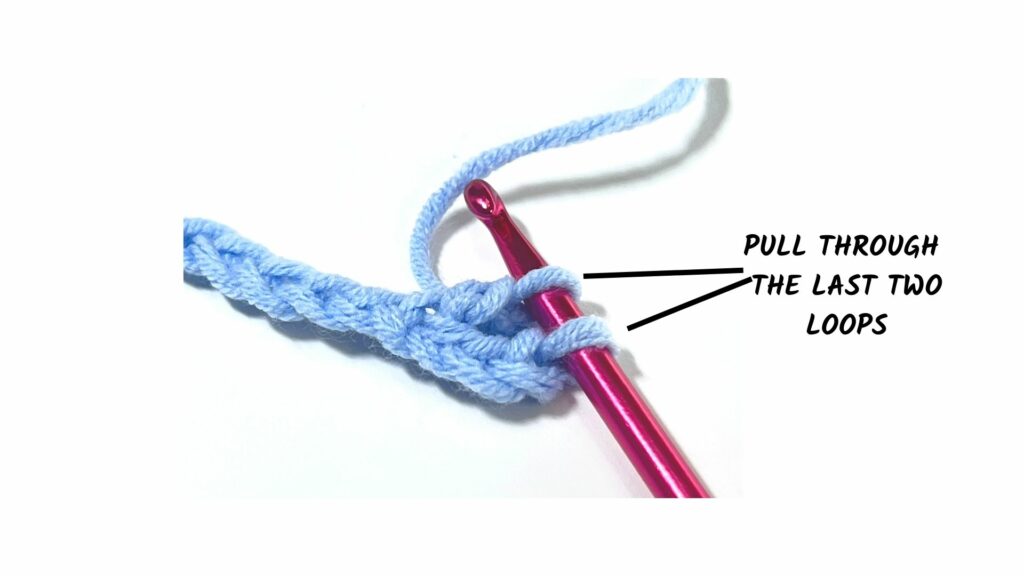
Once you’ve reached the end of your row, you should have 12 double crochets, counting the initial chain 3 as a double crochet.
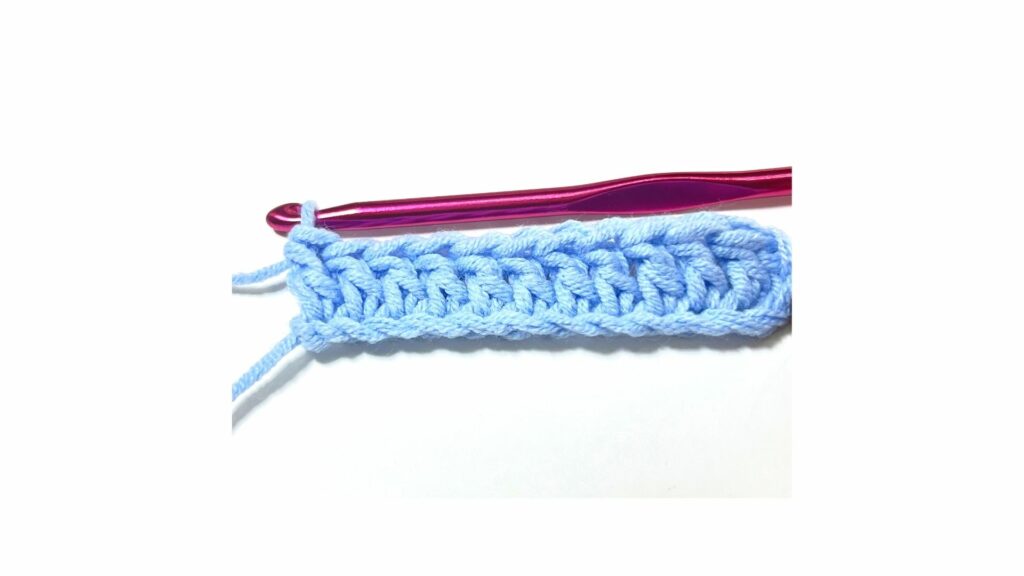
Turn your work.
Double Crochet Row 2
To begin your second row, and every row after it, you need to bring your work up to the same height as a double crochet to make room for the next row of stitches. In order to do that, you need to chain 3. This is what we call the turning chain. The turning chain counts as a double crochet stitch, which means you start by working into the second double crochet stitch.
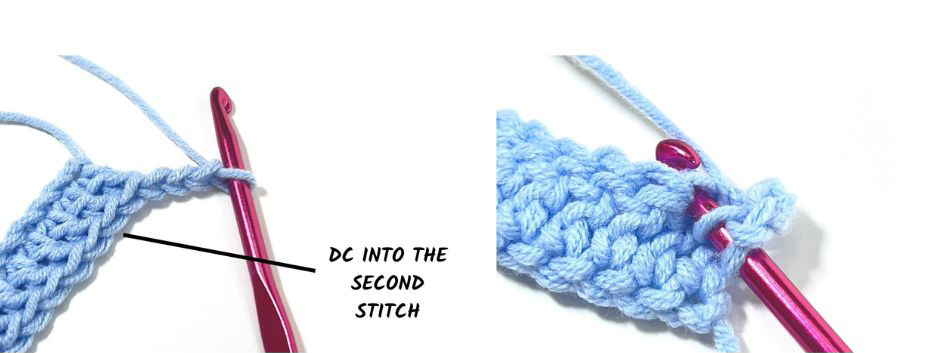
Every time you end your row from here on out, your last double crochet should be made on top of the turning chain you created at the beginning of your previous row.

Now that you’ve got the basics down, want to learn even more crochet stitches to play with? Our Ultimate Crochet Stitch Library has 45 different stitches explained with video tutorials and patterns you can use to practice!
How to Crochet Straight Edges With the Double Crochet Stitch
There are two ways to make sure that your edges stay straight while using double crochet, which is both fairly easy to figure out.
Method # 1
The first one is the same as what we discussed earlier: Chaining three and skipping the first stitch.
Here’s a play-by-play on how to do just that:
1. Start with a row of double crochet stitches.
2. After finishing a row, chain 3 and turn your work counterclockwise. The height of the chain 3 is the same as the height of a double crochet stitch, so you don’t have to work into the first stitch (the last stitch from the previous row.
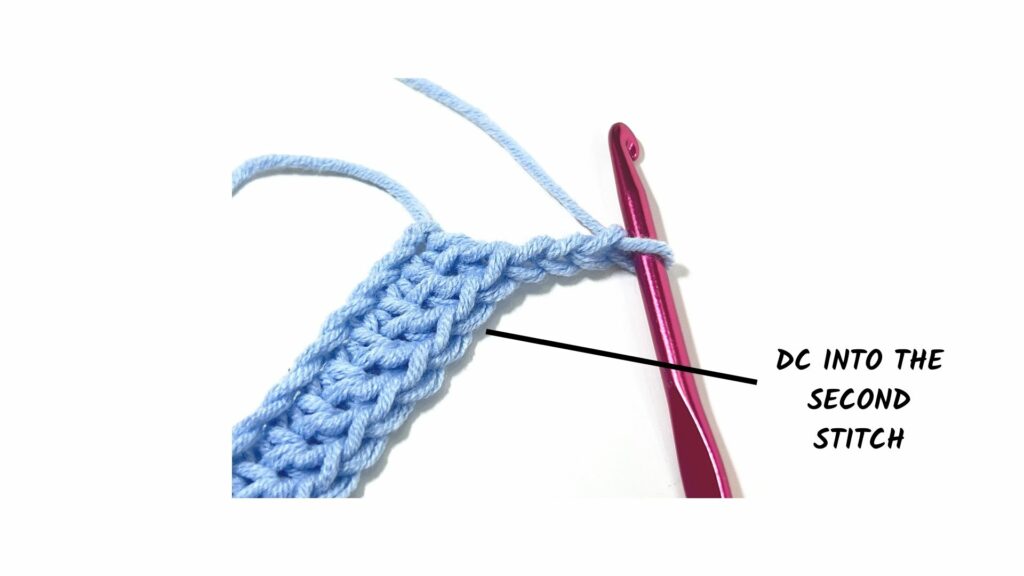
3. Make a double crochet in the second stitch. Since we’ve subbed in the chain 3 for a double crochet at the beginning, double crocheting into the first stitch would give us an extra stitch by the end, not to mention uneven sides.
4. Continue working double crochet stitch in each stitch of the row.
After crocheting a few rows, you’ll notice the slight gap created by your turning chain, but it still makes for a nice straight edge.
Method # 2
The second method for ensuring straight edges in double crochet is to shorten your turning chain into a ch 2 and not count it as a stitch.
Here’s how that would go:
1. Begin with a row of double crochets.
2. At the end of the row, chain 2 and turn your work.
3. Double crochet into the first stitch from the previous row, as shown below.
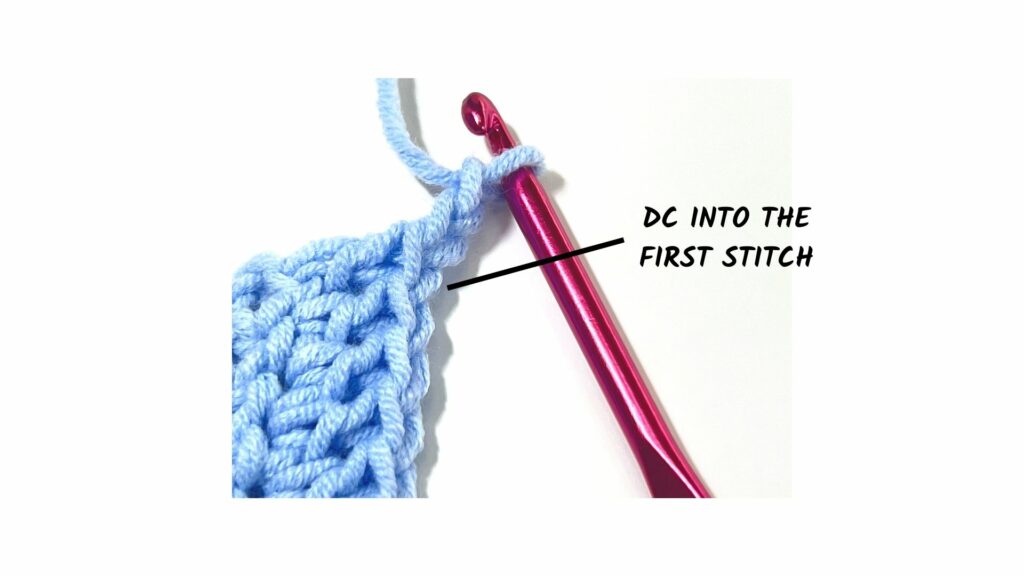
4. Dc into each stitch across.
Double Crochet Foundation Stitch (Fdc) – Alternative to Starting with the Basic Chain
Imagine you’re working on a large blanket or another project where you have to make a very long chain. Sometimes it’s difficult to keep your tension even on a long chain, and counting a chain that long to ensure you have the correct number of stitches is tedious.
It’s also a bit of a pain to go back and work your first row of stitches into a chain that long.
That’s why we have foundation stitches! There are single crochet and half double crochet foundation stitches, but right now, we’re talking about how to Foundation Double Crochet (Fdc)!
You can also use the Fdc for when you’re not sure how long a project’s starting chain should be, or when you just want a nice clean edge at the bottom of your work. It might look a little complicated but it makes it so your foundation chain and row 1 are done in one fell swoop!
How to Foundation Double Crochet (fdc)
- Begin with a slip knot and chain two.
- YO and insert your hook into the first chain you created. (This is the one farthest from the hook.)
- Pull up a loop. You should now have three loops on your hook.
- Yarn over and pull through one loop. This is going to count as the “foundation chain” and will make up the bottom of your first row. You should still have three loops on your hook. If you have trouble seeing where the chain is as you work, you can place the thumb of your left hand over the chain after you make it so you know where to put your hook to start the next stitch.
- YO and pull through the first two loops.
- YO again and pull through the last two loops. Steps 5-6 are what’s going to make the double crochet stitch.
- Next, YO and insert your hook through both sides of the chain you made in step 4. That’s the bottom part of your row if you remember.
- Pull up a loop. Make sure that it’s as tall as the two other loops on your hook to avoid curling.
- YO and pull through the first loop on your hook, just as you did on step 4. There should be 3 loops on your hook.
- YO again and pull through two loops.
- YO again and pull through the last two loops.
Repeat steps 7 to 11 until you reach your desired length.
Double Crochet Increases and Decreases
Why Do I Need to Increase and Decrease?
Increasing and decreasing in crochet are important skills to learn if you’re looking to experiment with different patterns. These two basically mean you’re either adding or reducing the number of stitches in a row as you go along in order to modify or change the shape of the fabric.
If you want to crochet something that fits a body, like a hat or a sweater, odds are good you’ll need to increase or decrease stitches along the way to make it work.
How to do a Double Crochet Increase
Increasing in double crochet means you double crochet two times in a single stitch.

When a pattern calls for you to double crochet increase (dc inc) into a stitch, you would work the first stitch as usual, then work another double crochet in the same stitch. This can also be written as 2dc with the number referring to how many double crochets you need to make in a stitch.
How to do a Double Crochet Decrease
Decreasing in double crochet, on the other hand, is made by skipping a chain or by joining two stitches (or more) into one double crochet. The latter is usually written as dc (number of stitches) tog in a pattern which basically means to double crochet a certain number of stitches together. For example, double crocheting two stitches together would be written as dc2tog.
Working a double crochet decrease is similar to making a standard double crochet stitch. The only difference is you stop making the first stitch after pulling through the first two loops on your hook and then start to make another dc in the next stitch.
1. Begin your double crochet by yarning over and inserting your hook into the stitch.

2. YO and pull up a loop. You should have three loops on your hook.
3. YO again and pull through the first two loops.
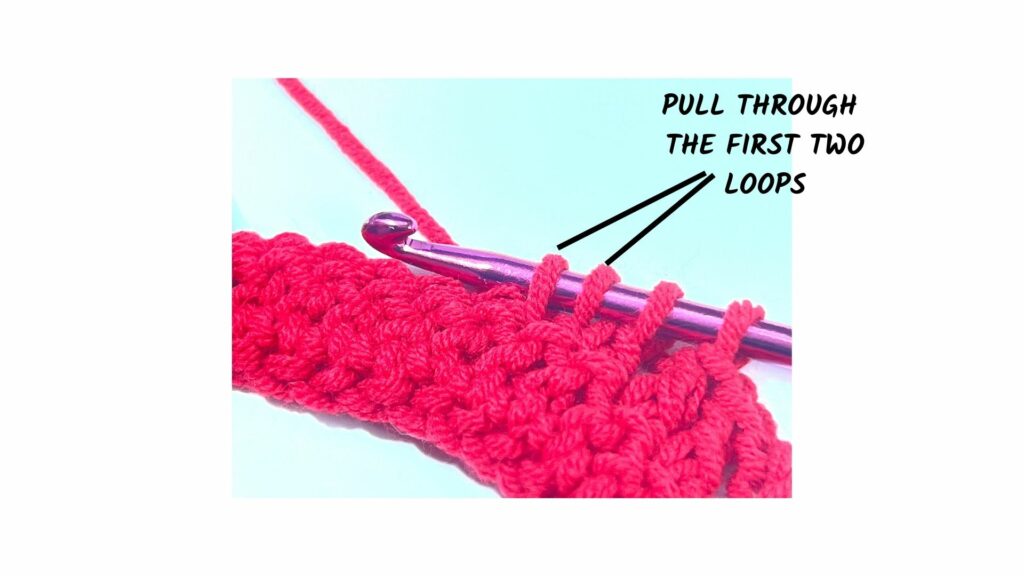
4. Now, with two loops on your hook, begin another double crochet by yarning over and inserting your hook into the next stitch, and pulling through a loop.
5. Then, yo again and pull through two loops. You should now have three loops on your hook.
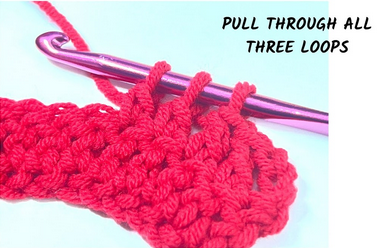
6. YO and pull through all three loops, and you just made a dc2tog!
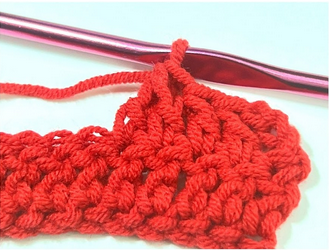
If the pattern calls for it, you can double crochet more stitches together. After step 5, you would begin another double crochet into the next stitch, and so on until you have begun the stitch in the number of stitches you need to work together. Then as you finish the last stitch you started, pull through all the loops remaining on the hook from the previous stitches.
Double Crochet Stitch In the Round
One way or another, a crocheter is going to find their way into a pattern that calls for them to work in rounds. In this section, we’ll talk about the different ways you can begin double crocheting in the round as well as how to end and start a new round.
How to Start a Double Crochet Circle
There are three ways to start your double crochet circle:
Option 1: Chain 3. Then work your double crochets into the first chain you made, that is, the third chain from your hook.
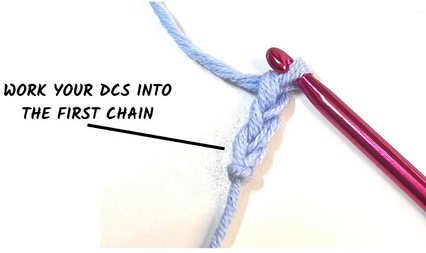
Option 2: Chain 3, then use a slip stitch to join the first and last chains together. The double crochets will then be worked into the middle of the ring you just created.
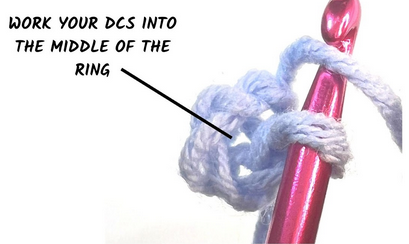
Option 3: Crochet a magic ring instead of a slip knot. Your double crochets will then be worked into the middle of the magic ring. To make a magic ring, start by forming a lowercase “d” with the yarn, with the tail end at the bottom front and a loop to the left in the working yarn. Hold the loop in your left hand, put the hook through the loop, yarn over and pull through a loop, then chain the required number of chains. Pull the tail end when you’ve completed your chains to close up the hole in the center.
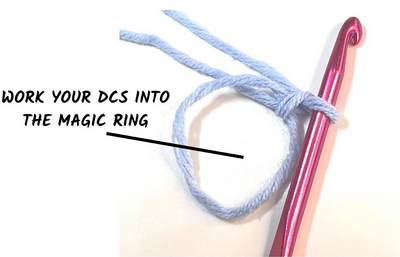
You can place as many double crochets as you want or as the pattern calls for into the circle.
Joined Round for Double Crochet
One way to end a round of double crochet or any other stitch is by slip stitching into the top of the chain 3 at the beginning of the circle. Chain 3 again and continue on to the next round.
Double Crochet in Continuous Rounds
The other way to continue onto your next round is by what is sometimes called spiral rounds or continuous rounds. After your last stitch, instead of slip-stitching into the first double crochet of the previous round, you’ll continue working the first stitch of the following round.

Spiral rounds make for a more seamless-looking piece that lays flat, but it can be a little difficult to keep track of when the rounds begin and end when you work this way. You can always place a locking stitch marker at the start of your round so you don’t lose track of it.
Tips for Perfect Double Crochet in the Round
So how do you make a perfect double crochet in the round? One thing that can help, just like with crocheting straight edges, is to chain 2 instead of 3 at the beginning/end of the round. Let’s give it a try with a set of 12 double crochet stitches.
- Crochet a magic ring and chain 2.
- Next, make 11 double crochets into the center of your magic ring.
- Close the magic ring by slip-stitching into the first double crochet you made. Take note that you are NOT slip stitching into the initial chain 2. 12 stitches total. (The combination of chain 2 and slip stitch counts as the twelfth double crochet.)
- For the second round, chain 2. Dc into the same stitch you slip stitched into to join the previous round.
- Work 2dc into each of the remaining stitches all the way around.
- Dc into the slip stitch from the previous round.
- Slip stitch into the first dc of the round (not the ch2) to join the round. 24 stitches total
To continue the pattern, increase each round evenly by 12 stitches. This is done by increasing the number of dc that come before the 2dc.
For example, in round 3 you would dc into a st, and 2dc into the next. You would continue this pattern of (dc, 2dc) until you finish the round with a dc in the previous sl st, and a sl st in the first dc of the round.
For round 4, the repeat would be (dc, dc, 2dc) while round 5 would be (dc, dc, dc, 2dc) and so forth until you reach your desired circumference.
Variations of the Double Crochet Stitch
The double crochet stitch is lovely as it is, but when you're ready to take it to the next level then you might want to learn some of these incredible variations! Each stitch is linked to free crochet patterns so you can get right into the thick of it!
Front Post Double Crochet Stitch (Fpdc)
Front Post Double Crochet is probably the post stitch you will see the most often, so it’s a great place to start when you are learning post stitches.
The Fpdc is made by yarning over, then starting with your hook in front of your fabric, going through the gap on the right side of the post, coming back out the other side, and making the double crochet as usual from that point.
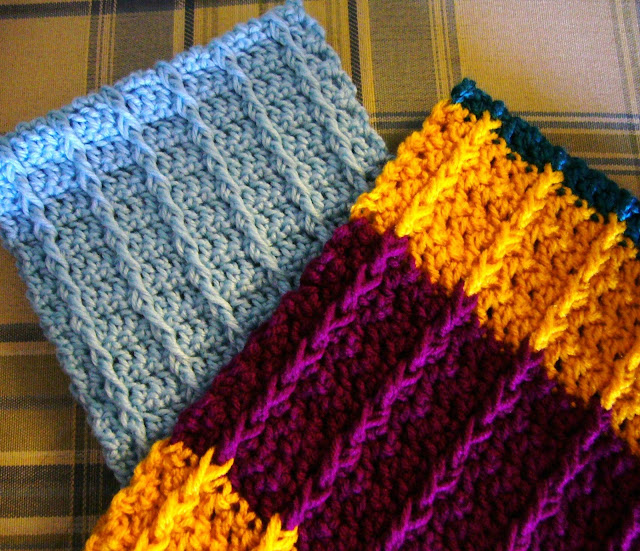
Front Post Scarf Pattern
Designer: Simply Shoeboxes
Yarn weight: (4) Worsted
Suggested yarn: EweEwe Wooly Worsted Merino Yarn
This front post double crochet scarf allows the stitch’s texture to stand out. The pattern works up quickly and is perfect for staying warm during the winter months! Mix it up with different colors or use a single color for a classic look.
Back Post Double Crochet Stitch (Bpdc)
Similar to the Fpdc, the Back Post Double Crochet is a post stitch. The only difference is that your hook starts from the back of the fabric and comes out to the front, wrapping around the post, and returning to the back.
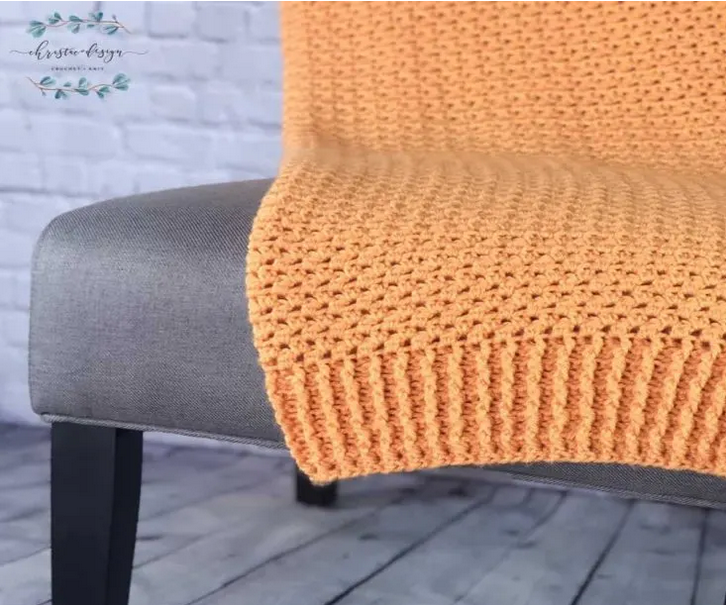
Between Ridges Blanket Pattern
Designer: CristaCo Design
Yarn weight: (4) Worsted
Suggested yarn: Lion Brand Pound of Love
The kind of cozy throw that’ll keep you in bed a little longer, this blanket pattern makes for the perfect companion on a rainy morning or any other time. It will give you lots of practice with both front post and back post double crochet stitches.
Linked Double Crochet Stitch
Double crochets aren’t known for making a dense fabric, which is why the Linked Double Crochet Stitch is the perfect variation to use for projects that need a more solid look! It’s formed by working into the previous stitch and the next stitch in the row at the same time, giving your stitches a condensed look and warm feel.

Linked Double Crochet Beanie Pattern
Designer: Tara Bryant/Ravelry
Yarn weight: (4) Worsted
Suggested yarn: Vanna's Choice
This super cute beanie uses a linked double crochet stitch for a super warm hat without all the holes. It gives you the option of working the whole hat using linked stitches or working a brim in other stitches (such as Fpdc and Bpdc) and sewing it onto the hat after stitching.
Herringbone Double Crochet Stitch
The Herringbone Double Crochet Stitch makes for a beautifully textured fabric. The stitch is similar to a standard dc other than the fact that you YO and pull through one loop twice before yarning over and pulling through the last two loops.

The Bixby Crochet Cowl Pattern
Designer: Make and Do Crew
Yarn weight: (6) Super Bulky
Suggested yarn: Lion Brand Wool-Ease Thick & Quick Yarn
A gorgeous and chunky cowl that’ll keep you warm and looking fashionable, the Bixby Cowl owes its unique texture to the herringbone double crochet stitch! It’s such a great chunky project that will keep you warm whatever the weather, and makes a great gift!
Extended Double Crochet Stitch (Edc)
Another gorgeous variation on double crochet, the Extended Double Crochet gives the fabric a little more height and a little more pliability. An edc is made by starting a double crochet as usual until you have three loops on your hook, then you YO and pull through one loop before continuing with the rest of the double crochet.
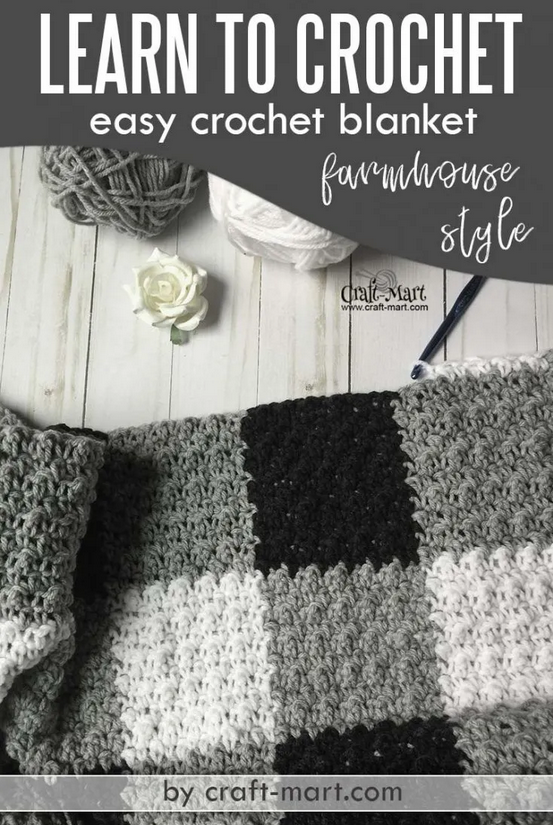
Farmhouse Blanket Pattern
Designer: Craft Mart
Yarn weight: (4) Worsted
Suggested yarn: Touch of Alpaca
This farmhouse-style blanket is reversible, easy to learn, and makes for a gorgeous throw on the couch! The plaid design looks complicated but it isn't difficult at all, while the extended double crochet is easy to learn.
Double Crochet V-Stitch
The double crochet V-stitch creates an eye-catching texture for your project using only a repeating pattern of dc, ch 1, dc in the same stitch across your work.
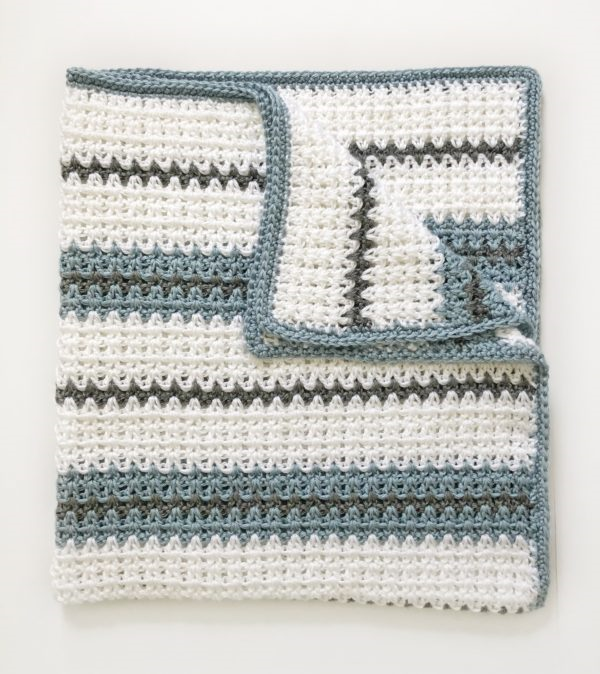
Modern Double Crochet V-stitch Blanket Pattern
Designer: Daisy Farm Crafts
Yarn weight: (4) Worsted
Suggested yarn: Feels Like Butta
This striped blanket gets its unique stitch texture from the double crochet v-stitches. This would be lovely in a solid color or using a few stripes to mix it up as the original designer did. Choose a couple of pretty colors or use all the leftovers in your stash!
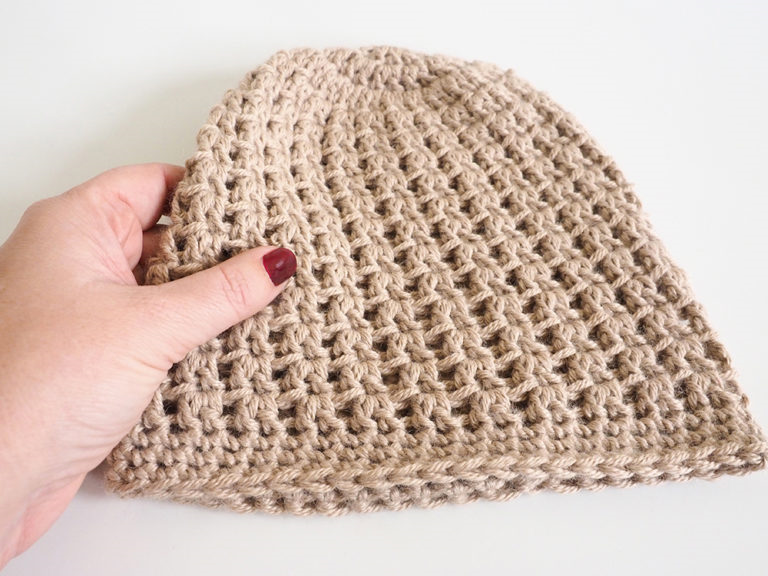
Double V Slouch Beanie
Designer: Simply Collectible Crochet
Yarn weight: (3) DK
Suggested yarn: Berroco Vintage DK
This fun beanie uses a V-stitch variation of two double crochets with two chains between them, which gives the finished hat a bold textured look without a lot of work on your part. The pattern offers an option to finish with a brim worked in single crochet or to work the whole hat in the double v pattern.
Double Crochet in Corner to Corner Crochet (C2C)
As the name suggests, corner-to-corner crochet (often abbreviated as c2c) is a technique that is worked in blocks diagonally from one corner to the other. Think of it like pixel art, except each pixel is a block of three chains and three double crochets that are connected to other blocks!
Corner-to-corner projects can be worked in many different stitch patterns, but double crochet is commonly used.
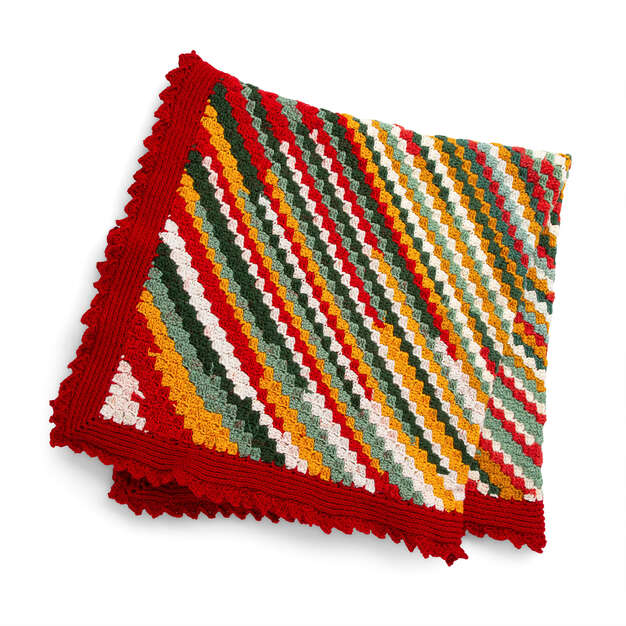
Crochet Corner to Corner Throw
Designer: Yarnspirations
Yarn weight: (4) Worsted
Suggested yarn: Universal Uptown Worsted
Learn the c2c technique with this easy and colorful project that uses multicolored yarn so you don’t have to worry about when or how to change colors. The edging adds in some different stitch techniques but you can leave it off or do a single or double crochet edging if you’d rather.
Common Double Crochet Mistakes
Every crocheter makes mistakes from time to time, and there are a few ways that you can end up with double crochet fabric that doesn’t look quite the way you intend. The good news is these common mistakes in double crochet are easy to fix.
Gaps and Holes Near the Turning Chain
As mentioned previously, the turning chain for double crochet rows is usually 3 stitches and counts as a double crochet itself. But this creates a gap at the sides of your rows which you might not want.
This can easily be avoided by using a shorter turning chain (chain 2 instead of chain 3) or by not counting the turning chain as a stitch.
Having More or Fewer Stitches in the Row Than Needed
You could be casually crocheting along only to look down and notice that your fabric is getting wider and wider (or narrower!) as you go along. This super frustrating occurrence is also really common in double crochet.
The easiest way to avoid this, especially for beginners, is to keep counting your stitches at the end of every couple of rows. If you started with 20 double crochets and the pattern doesn’t call for any increases or decreases, then you should still have 20 double crochets by the time you reach the end of the row – or the project!
The problem could also lie in where you place your double crochets. Whatever turning chain you’re using, make sure you stay consistent as you add more rows in terms of how long it is and whether you are counting it as a stitch. With a little more love and attention, your crochet projects will be golden!
Double Crochet Stitch Too Tight or Too Loose
Sometimes a project just doesn’t come out the size you intended. If you’ve crocheted a project that is much bigger or much smaller than you expected, it could be because your stitches are too tight or too loose.
If you’re making an accessory like a scarf, throw, or another project that doesn’t have to be perfectly sized, this problem isn’t the end of the world, but if you’re stitching a garment it can be the difference between something that fits and something that doesn’t.
There can be a lot of reasons your project comes out a different size than you intended (such as using a different yarn weight or hook size than what was called for) but the remedy is to get in the habit of working a gauge swatch before you start on your project.
A gauge swatch is a square of crochet worked in the yarn and with the hook and stitch you want to use for your project. It should be at least 5 inches square. Work it, fasten off, wash it if you plan to wash your finished project, then measure how many stitches you are getting per inch (typically this is done by measuring and counting over 4 inches then dividing by 4).
The pattern should tell you what gauge you should be getting with the yarn and hook specified. If you are getting more stitches per inch, your stitches are too loose and you need to use a bigger hook. Likewise, if you have too few stitches you need a smaller hook.
Crochet Patterns I Can Make with the Double Crochet Stitch
The double crochet stitch is an extremely versatile stitch that you can use with almost any kind of pattern. It is one of the easiest and fastest stitches out there once you get the hang of it, and the look of the stitches is nice, neither too open and loose nor too tight and thick.
We've linked several free patterns below arranged by category so you'll never run out of new things to create!
Double Crochet Blanket Patterns
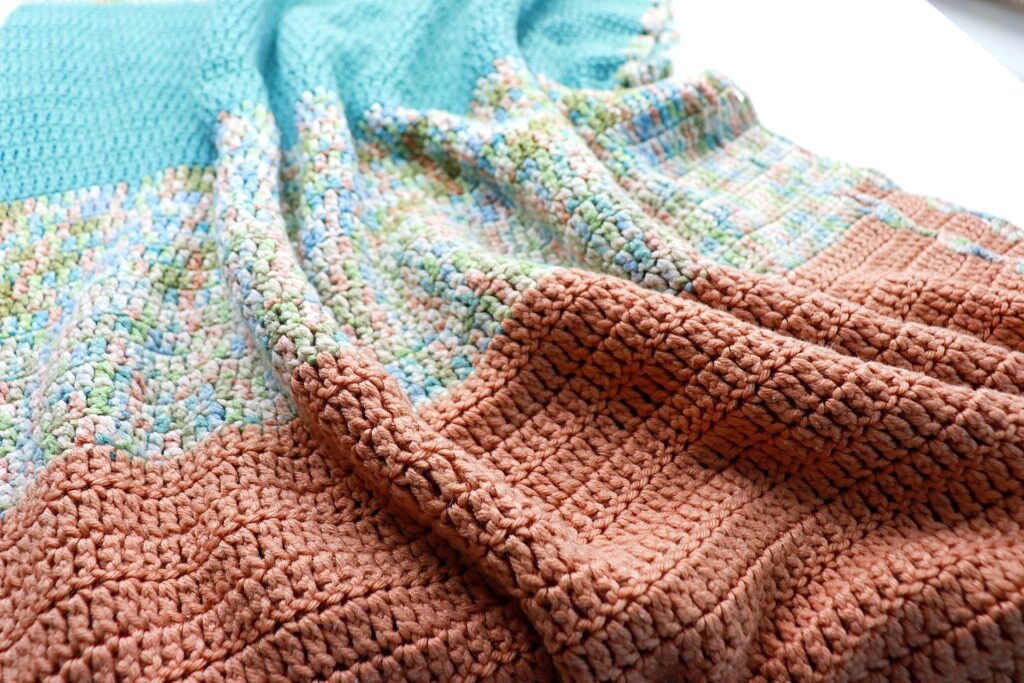
The Forever Blanket Pattern
Designer: Sigoni Macaroni
Yarn weight: (4) Worsted
Suggested yarn: Landscape Yarn
This is a great, simple double crochet blanket you can work on mindlessly that’ll give you a gorgeous throw that you can use for years and years! The designer used Red Heart Super Saver Yarn but you can take it a step further by using their Ombré collection for a lovely gradient look if you like.
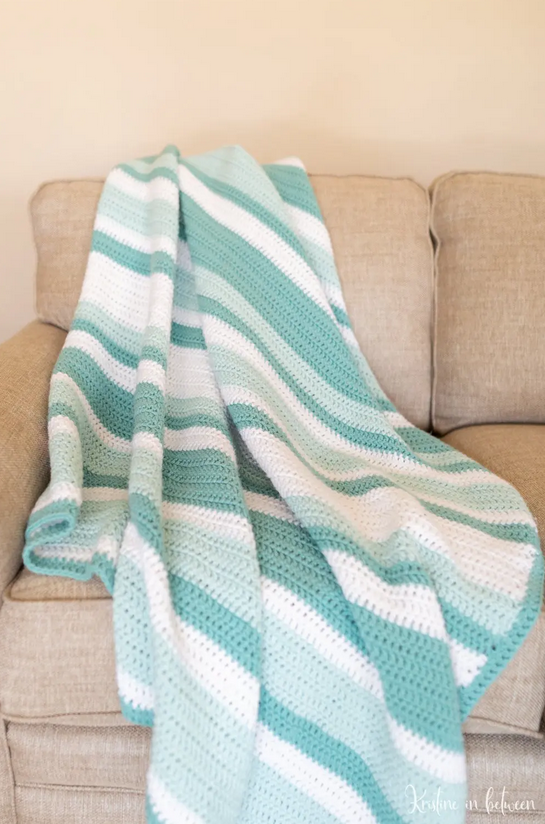
All Double Crochet Afghan Pattern
Designer: Kristine in Between
Yarn weight: (4) Medium
Suggested yarn: Lion Brand Touch of Alpaca Yarn
This throw-sized, beautifully designed crochet afghan is worked in double crochets with minimal color changes, making it perfect for beginners looking to work on their first big project!

Which Way Baby Blanket Pattern
Designer: Caitlin’s Contagious Creations/Underground Crafter
Yarn weight: (4) Medium
Suggested yarn: Lion Brand A Star is Born: Naptime
Beginner-friendly and perfect for the babies in your life, this crocheted blanket is elegant and easy to play around with. Try it in solid pastels or switch colors every few rows for a gorgeous striped design!
Double Crochet Hat Patterns
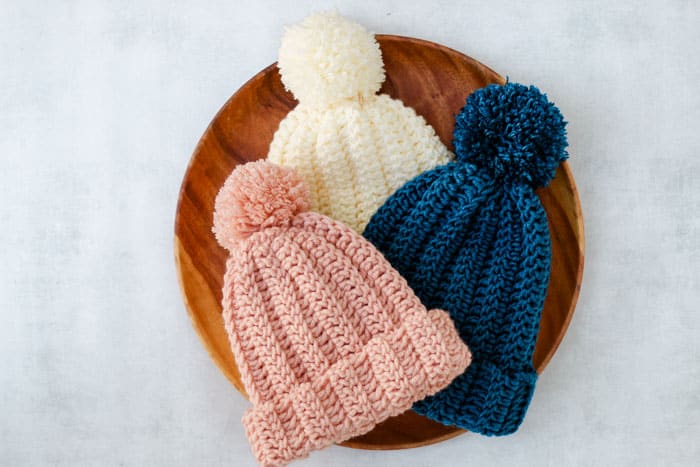
1.5-Hour Beanie Pattern
Designer: Make and Do Crew
Yarn weight: (5) Bulky
Suggested yarn: Lion Brand Feels Like Bliss Yarn
Looking for a quick crochet palate cleanser? This gorgeous ribbed beanie works up quickly and makes for the perfect gift for both friends and family! The yarn used in the original has been discontinued, but there are a lot of great bulky yarns you can use for this project.
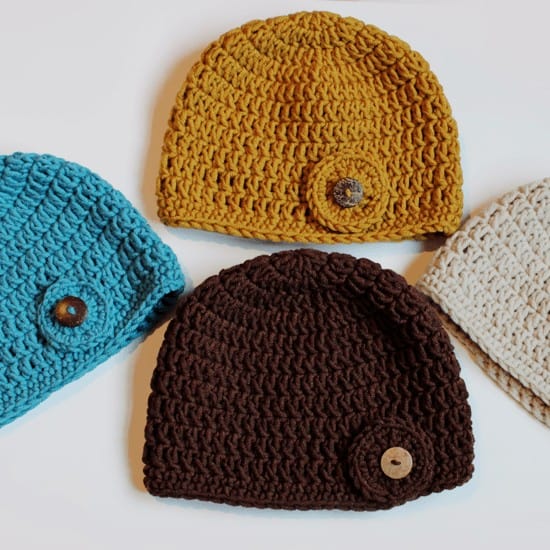
Double Crochet Beanie Pattern
Designer: Easy Crochet
Yarn weight: (6) Super Bulky
Suggested yarn: Lion Brand Feels Like Butta Thick & Quick Yarn
This fluffy beanie is worked in double crochets using a super bulky yarn, giving it an extra ounce of coziness! There’s a variation where you can make it without the button, but let’s be honest, that button just adds to the look perfectly!
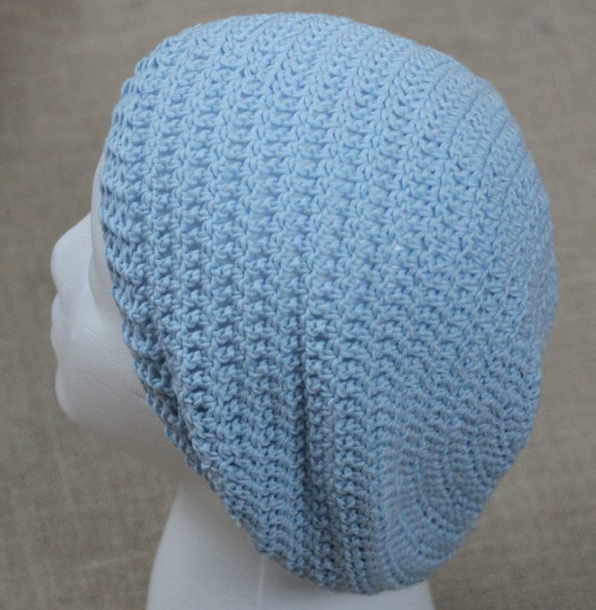
Mercedes Slouch Hat
Designer: Cream of the Crop Crochet
Yarn weight: (2) Fine
Suggested yarn: Lion Brand Cotton Bamboo Linen
This fun slouchy hat uses double crochet throughout the body and front and back post single crochet for the brim. Since you already know how to do front and back post double crochet, this is the same concept, just working single crochets around the posts instead of doubles.
Double Crochet Scarf Patterns
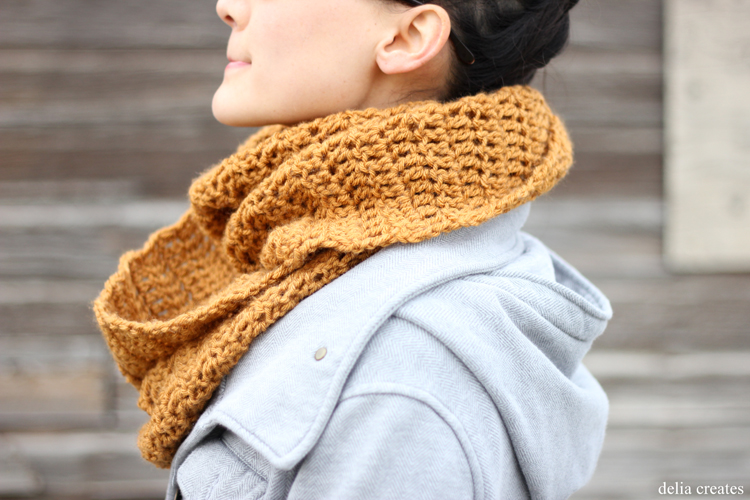
Double Crochet Infinity Scarf Pattern
Designer: Delia Creates
Yarn weight: (4) Worsted
Suggested yarn: Lion Brand Vanna’s Choice Yarn
Scarves are one of the most beginner-friendly patterns a crocheter could ask for! Practice your tension and your stitch-counting with rows and rows of double crochet and then seam the ends together for a stylish and comfy infinity scarf!
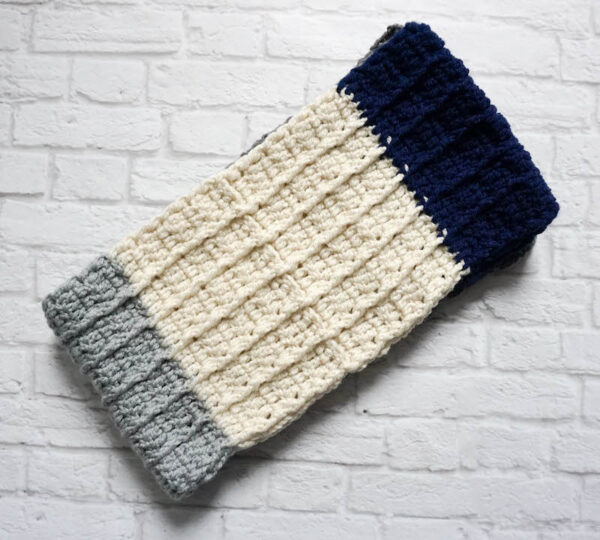
Gridlocked Scarf Pattern
Designer: Underground Crafter
Yarn weight: (4) Worsted
Suggested yarn: Knit Picks High Desert Worsted
This gorgeous gridlocked scarf uses a combination of double crochets as well as front and back post double crochet stitches. Once you’re done, you’ll be left with a beautifully textured scarf that’ll keep you cozy all winter long!
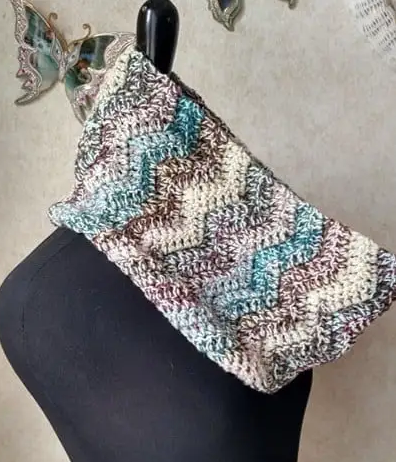
Felici on the Double Cowl Pattern
Designer: Rows and Roses
Yarn weight: (1) Fingering
Suggested yarn: Knit Picks Felici Sock Yarn
Made specifically to be worked with Knit Pick’s Special Reserve yarn, Felici, this beautiful cowl is worked holding two strands of yarn at the same time. Get your dc2tog practice in making this fun chevron design, and end up with a beautiful gift for your friends!
Double Crochet Dishcloth Patterns

Nantucket Easy Double Crochet Dishcloth Pattern
Designer: Stitching Together
Yarn weight: (4) Worsted
Suggested yarn: Knit Picks Dishie Yarn
Planning to make a dishcloth? You’ll want to make a whole stack in every color you desire with the help of this easy-to-follow pattern and your favorite cotton yarn. Washcloths and dishcloths are a great way to learn new stitches and it doesn’t get any easier than these!
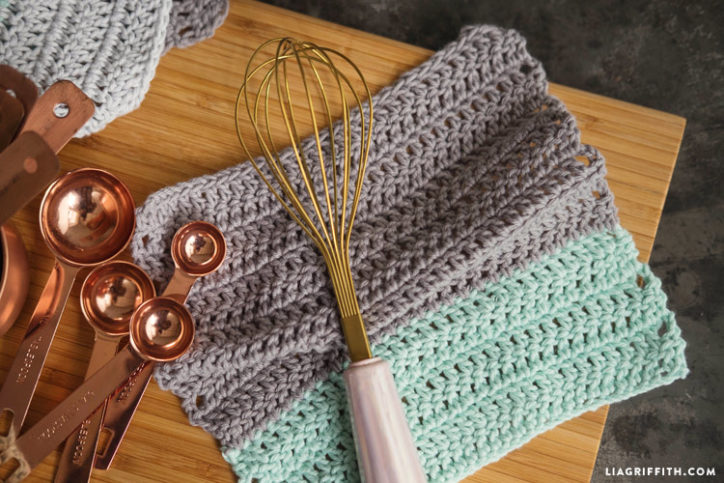
Double Crocheted DIY Dishcloth Pattern
Designer: Lia Griffith
Yarn weight: (4) Worsted
Suggested yarn: Knit Picks Dishie Yarn
This simple double crochet dishcloth is color blocked for extra fun. Or you can use all the leftover cotton bits from other projects to make funky cloths; I promise your dishes won’t mind.
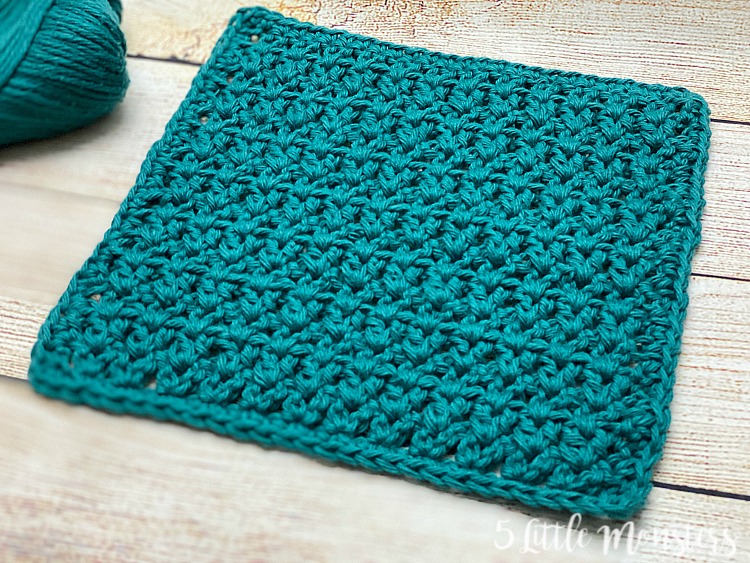
Double Double Crocheted Dishcloth Pattern
Designer: 5 Little Monsters
Yarn weight: (3) DK
Suggested yarn: Cascade Ultra Pima
These cute little dishcloths are made with a variation of the double crochet v-stitch that makes them more solid and creates a beautiful texture that’s sure to stand out in your kitchen!
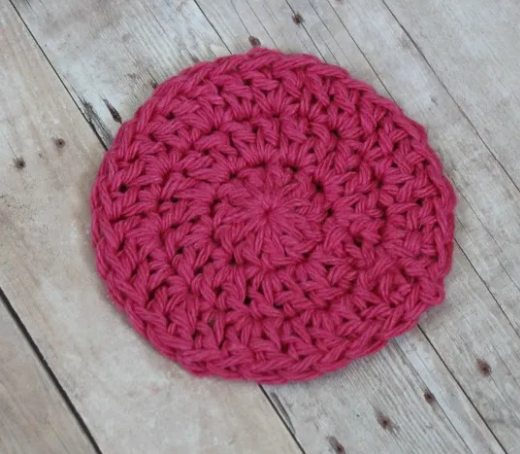
Double Crochet Face Scrubbie
Designer: Cream of the Crop Crochet
Yarn weight: (4) Worsted
Suggested yarn: Lion Brand 24/7Cotton
Practice your double crochet in the round with this quick and easy face scrubbie pattern. You can make one in minutes and have a whole stack in no time to use to wash your face, remove makeup, or do other small cleaning jobs.
Double Crochet Chevron Patterns
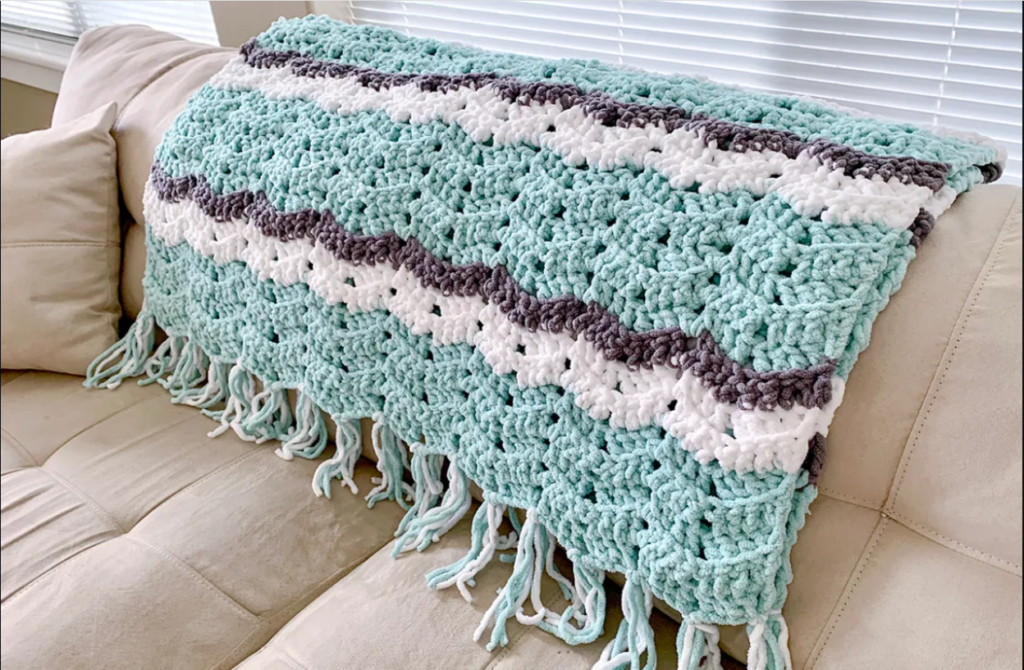
Easy Weekend Chevron Crochet Pattern
Designer: Double Crochet
Yarn weight: (6) Super bulky
Suggested yarn: Lion Brand Hometown
Chevrons are an elegant design that’s much-beloved in the crochet community. They are often worked with double crochet stitches like this beginner-friendly (and super fast to stitch) throw.
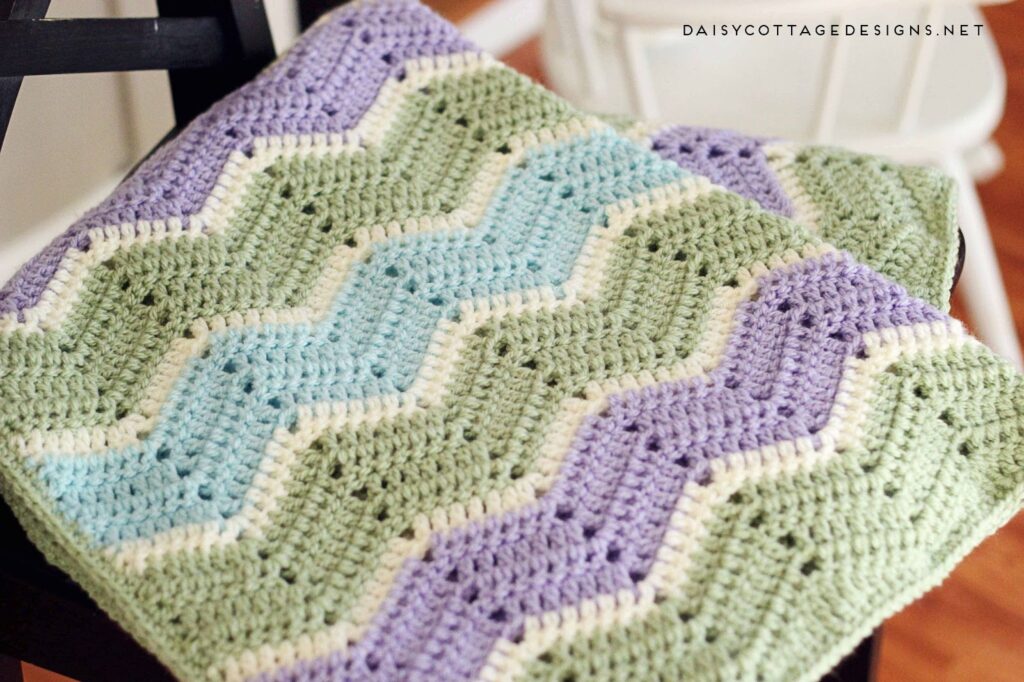
Easy Chevron Pattern
Designer: Daisy Cottage Designs
Yarn weight: (4) Worsted
Suggested yarn: Lion Brand Pound of Love
When it comes down to it, chevrons are basically just double crochets and chains that make peaks and valleys in your fabric. This easy blanket worked in simple stripes is a great way to gain confidence in working chevrons, and a great new blanket to boot.
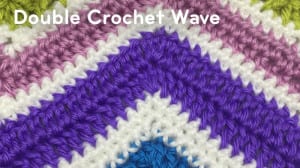
Double Crochet Waves Pattern
Designer: The Crochet Crowd
Yarn weight: (4) Worsted
Suggested yarn: Lion Brand Feels Like Butta
This pattern was made to be adjustable in size, so you can make anything your heart desires, whether it’s a scarf, blanket, or dishcloth.
Do You Want to Learn to Make More Interesting Crochet Stitches?
The double crochet stitch in and of itself has so much room for variation and creativity. But there are so many other crochet stitches out there you can learn and use to personalize all your projects.
The Ultimate Crochet Stitch Library is your one-stop shop for every stitch you’ll ever want to learn. Create an endless amount of unique pieces and projects with these fantastic stitches!
Foundational Crochet Skills – Learn How to Crochet?
Crochet seems like the simplest hobby once you understand how it works. However, just like all the avenues the double crochet stitch alone has opened up for us, it always helps if you have a firm understanding of the fundamentals first!
Go back to the basics, get familiar with your yarns and hooks, and really dive deep into the foundational crochet skills you need to create timeless, beautifully crafted pieces for you and your loved ones in our Crochet Fundamentals workshop.
Here you’ll learn everything from the different ways to hold a hook to basic stitches, skill-building patterns and so much more that will build a solid foundation for anything you want to crochet.


Leave a Reply